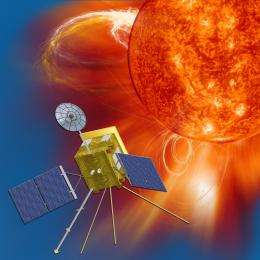SPICE mission to explore the center of the solar system

An imaging coronal spectrograph called SPICE (Spectral Imaging of the Coronal Environment), designed by scientists and engineers at Southwest Research Institute in Boulder has been selected by ESA and NASA for the European Space Agency's Solar Orbiter mission to explore the innermost regions of the solar system from the closest distances to the Sun ever attempted. Solar Orbiter will be positioned at a unique vantage point, about one-fourth the distance of the Earth from the Sun.
The SPICE instrument is one of 10 selected to fly aboard the joint ESA/NASA Solar Orbiter mission. SPICE will measure different wavelengths of light emitted from the Sun to evaluate its plasma properties and composition using unprecedented spatial and spectral resolution. The data will advance our knowledge of the Sun's dynamics to better understand the effects on Earth and the solar system.
SwRI researchers designed SPICE to remotely measure plasma properties at and near the Sun and to help researchers understand the connection between in-situ measurements of the solar wind and its source regions near the Sun.
"SPICE is uniquely suited to fill a critical gap in our understanding of the basic conditions near the Sun and how these conditions effect the solar wind and its impact on the Earth," says Dr. Don Hassler, SPICE principal investigator and senior research scientist in the Boulder office of SwRI's Space Science and Engineering Division.
The SPICE investigation is part of NASA's Living with a Star Program, which is designed to understand how and why the Sun varies, how planetary systems respond, and the effects on human space and Earth activities. NASA's Goddard Space Flight Center manages the program for the agency's Heliophysics Division of the Science Mission Directorate.
"One of the greatest threats to human space exploration is the sudden, unpredictable occurrence of radiation outbursts from the Sun," says Hassler. "Even satellites and power grids on and around Earth are at risk. By improving our understanding of the dynamics of the Sun, SPICE will help develop the capability for forecasting and predicting solar conditions that could affect space travelers as well as life here on Earth."
SwRI is leading the development of SPICE, in collaboration with NASA's Goddard Space Flight Center (Greenbelt, Md.), Rutherford Appleton Laboratory (United Kingdom), Max Planck Institute (Germany), Institut d'Astrophysique Spatiale (France) and Institute for Theoretical Physics (Norway). The Solar Orbiter spacecraft is currently scheduled for launch in 2017.
Since the early 1990s, SwRI has developed instruments and spacecraft that measure radiation levels and observe heliospheric interactions, including the Radiation Assessment Detector (RAD) onboard the Mars Science Laboratory (MSL), the Imager for Magnetopause-to-Aurora Exploration (IMAGE) spacecraft, and the forthcoming Magnetospheric Multiscale (MMS) spacecraft.
Source: Southwest Research Institute




















